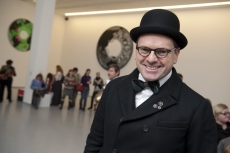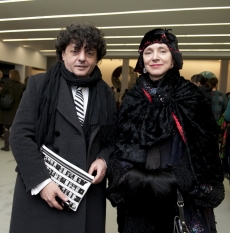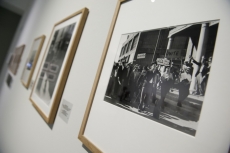Charlie Chaplin









Charles Chaplin, The Rink (1916). © Bubbles Inc., courtesy NBC Photographie, Paris
Building of the Chaplin Studios, Los Angeles. Charles Chaplin turns the first sod. (Nov. 1917). © Roy Export Company Establishment, courtesy NBC Photographie, Paris
Boxing with actor Mack Swain in his Gold Rush costume. The referee is the real boxer Kid McCoy. (1923-1925). © Roy Export Company Establishment, courtesy NBC Photographie, Paris
Charlie’s poses (c. 1915). © Bubbles Inc., courtesy NBC Photographie, Paris
Charlie’s poses (c. 1915). © Bubbles Inc., courtesy NBC Photographie, Paris
Charles Chaplin, A Jitney Elopement (1915). © From the Archives of the Roy Export Company Establishment, courtesy NBC Photographie, Paris
Charles Chaplin, The Pilgrim (1922). © Roy Export Company Establishment, courtesy NBC Photographie, Paris
Charles Chaplin, on the set of Modern Times (1936). © Roy Export Company Establishment, courtesy NBC Photographie, Paris
Charles Chaplin, Modern Times (1936). © Roy Export Company Establishment, courtesy NBC Photographie, Paris
Charles Chaplin and his team on the set of Modern Times (1936). © Roy Export Company Establishment, courtesy NBC Photographie, Paris
Charles Chaplin, The Great Dictator (1940). © Roy Export Company Establishment, courtesy NBC Photographie, Paris
Charles Chaplin and Buster Keaton, Limelight (1952). © Roy Export Company Establishment, courtesy NBC Photographie, Paris
Moscow, 30.11.2012—14.02.2013
exhibition is over
Share with friends
Curator: Sam Stourdzé
«I feel uncomfortable when asked the secret of how I make an audience laugh. There is no mystery connected with making people laugh...» - Charlie Chaplin
For the press
Hard to find a better-known character in cinema history than Charlie Chaplin. The bowler hat, moustache, funny walk and cane are instantly recognisable. This exhibition at the Multimedia Art Museum in Moscow is another attempt to discover who he really was — Charles Chaplin, an actor, director and production designer who made the whole world laugh.
From the first short, Kid Auto Races At Venice, to the heights of fame and his own studio with 70 feature films to its name — visitors to the exhibition can witness the emergence and development of Chaplin’s character. At the very beginning this was a bold and crafty opportunist who thought nothing of robbing his buddies or running after the neighbour’s wife, and Chaplin had a long journey ahead before arriving at the sentimental and extraordinarily talented Tramp. Rare documentary material bears testimony to the stages in which his character developed (the exhibits include photographs from film company archives where Chaplin worked, and fragments from his own photo and video archives); moreover, the curator always keeps in the field of vision the real Charles Chaplin’s biography and its various upheavals: court proceedings, revocation of his American visa, active involvement in civil liberties, political beliefs, etc.
The exhibition is in six main sections, each representing a separate aspect of the real Chaplin, the man and the actor, and visitors have the rare opportunity to see for themselves how and when Chaplin’s screen image appeared, the techniques he used for comic effect and the wide-ranging talent that enabled him to be ’all and sundry’ in his movies: filmmaker, director, actor, composer and producer. For example, the ’Choreography of Movement’ section is devoted entirely to Chaplin’s unique plasticity: his movements are reminiscent of a dance, and the sequence of motion is rather like an avant-garde ballet. The great Russian dancer Vaslav Nijinsky met Chaplin and genuinely admired his ’dancing’, while Chaplin called Nijinsky ’one of the few real geniuses’ he had encountered. Chaplin’s presence in ’highbrow’ avant-garde culture is one of the most interesting topics covered by the exhibition: for instance, the Little Tramp plays the leading role in a screenplay written by Fernand Léger as part of his legendary Ballet Mécanique, and artists have frequently derived inspiration from Chaplin’s image charged with symbolism and dynamic plasticity. In Léger’s sketches the figure is broken apart, then reconstructed, and the features of his silhouette yield to Cubist decomposition.
As if in jest, Chaplin has entered the ’mainstream’ of 20th-century culture and become an intrinsic part of it. Not only inventing a new type of humour and creating his own school of direction, he also transformed his image into a symbol that shines like a beacon through the passing years and continues to make audiences laugh.
Charlie Chaplin was born in London on 16 April 1889. He died in Vevey, Switzerland, on 25 December 1977.
At the age of twenty he set out with the Fred Karno music hall troupe to the United States, where he caught the eye of Mack Sennett, head of Keystone Studios.
His first short, Making a Living, dates from 1914 and it was in the second, Kid Auto Races at Venice, that Charlie the Little Tramp made his first appearance. Between 1914 and 1923 Chaplin made over 70 short films.
After completing The Gold Rush in 1925 — the film is eighty years old this year — Chaplin began to slow down his output and concentrate on feature-length movies. Between 1925 and 1967 he made eight films, among them The Circus (1928), City Lights (1931), Modern Times (1936), The Great Dictator (1940) and Limelight (1952).
Initially an actor, Chaplin turned himself into a one-man band, directing and producing his films and composing the music for them as well.
Exhibition organised with the backing of the Chaplin Association
in conjunction with the Cineteca del Comune di Bologna – projetto Chaplin, and MK2.





































